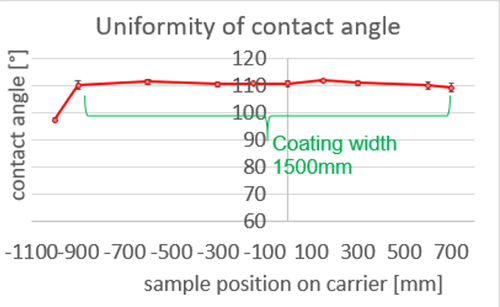Typical optical coatings for display cover glasses are anti-reflective stacks consisting of four to eight layers, which reduce the visual reflectance from about 4 percent to below 0.25 percent. Other important performance criteria of these AR stacks are optical transmission and reflectance color consistency during production. This color deviation needs a delta E of less than 2.5, which implies an average thickness uniformity of all layers in the range of plus minus one percent.
The glass surface of touchscreens is constantly touched with bare fingers, which causes fingerprints and smearing. Therefore, an easy-to-clean coating is applied to limit these effects and enhance the cleanability of the screen. The ETC coating consists of a hydrophobic and oleophobic layer that is a few nanometers thin. It reduces fingerprints and improves tribology and haptics of the surface.
Two Coatings in One System and One Coating Cycle
In standard display coating procedures, the coating chamber must be evacuated in between the different coating steps and, if a wet process is used, a drying unit is necessary too. This requires a lot of time and energy.
VON ARDENNE has tackled this issue by developing equipment for display applications that can deposit anti-reflective and easy-to-clean coatings in a single coating cycle. That means that it is not necessary to break the vacuum or to use a drying unit. As a result, the productivity of the manufacturing process is improved by 20-30 percent and the lifetime of the displays is increased by approx. 25 percent as well.
For ETC coatings, we evaporate a dedicated monomer, which forms a strong chemical bond with the silicon top surface of the anti-reflection coating. To evaporate such ETC monomers, VON ARDENNE has developed a linear evaporation source that can be integrated into the AR sputtering equipment.
The ETC coating uniformity, wettability and abrasion resistance have been tested in collaboration with a partner company. As you can see in picture 2, the non-wetting contact angle is excellent and has not degraded over thousands of abrasion test cycles.
For these applications, VON ARDENNE has refined the GC120VCR glass coating system, which is a platform for the mass production of coatings on cover glasses. It is a vertical sputtering system for depositing functional layers on glass substrates with a size of up to 1.2 meters by 1.6 meters. These coaters can provide a productivity of up to one million square meters of coated glass per year.
Process Monitoring and Control
To achieve such uniformities below plus minus one percent, the industrial-scales reactive sputtering equipment requires advanced monitoring and control systems. First, the process is optimized by using a dedicated reactive gas control system called VA PROCOS2. In addition, we are also using remotely adjustable magnet bars in our magnetrons, as well as optimized chamber and carrier design.
These implementations allow us to achieve uniformities of plus minus 0.73 percent for TiO2 layers and plus minus 0.65 percent for SiO2 layers on 1.2 meters by 1.2 meters single pane substrates, which are first-rate performances for this size of equipment.
To sustain such layer thickness uniformities for an entire production campaign, we have introduced an automatic closed-loop layer stack control system: the VA Processmaster, which is part of our VA INDIGO digital product and service platform. This system constantly monitors the thickness of all layers in a stack by measuring the optical spectra in-situ. And then it uses this data to control the sputtering processes.
The VA PROCESSMASTER also provides active support to the operator, allows fast production ramp-up and automated drift compensation to constantly keep the AR coatings close to the optical optimum. As a result, it is possible to deposit more challenging stacks at better yield and productivity.
There are new customer demands for higher quality and lower production costs. To meet these demands, we have developed both innovative technologies and new processes for the deposition of optical layer stacks and functional coatings on large-area cover glass.
Furthermore, VON ARDENNE has developed a family of highly productive vacuum coating systems that are optimized for our customers’ success. That includes many other coating applications such as automotive glass, fuel cells, battery components and sensors. For more information, click here.

